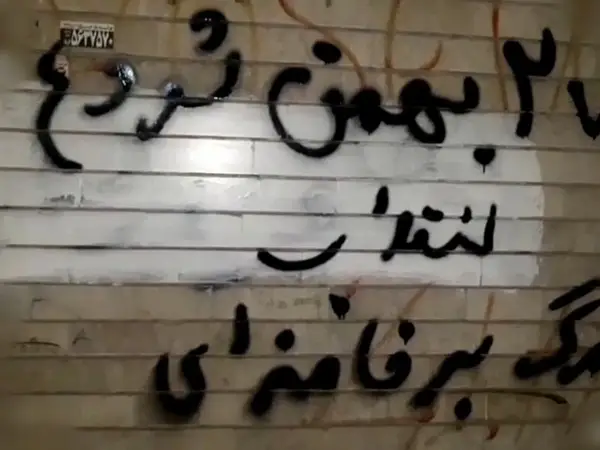Despite many parts of Iran being covered in snow, people continue to write slogans on walls and distribute flyers and posters calling for fresh protests.
They call for protests planned for February 16, which marks the 40th day after the execution of Mohammad-Mehdi Karami and Mohammad Hosseini, two of the four Iranians who were hanged for their participation in antigovernment rallies.
The 40th day of a loved one’s death – as well as the seventh day -- carries immense cultural significance in Iran, and in case of an unjust killing, such as the young protesters killed by security agents, the occasion turns into public mourning and fuels angry protests.
Graffiti on walls and fliers proclaim, "Start of the revolution."
Karami and Hosseini had been arrested in the city of Karaj during demonstrations om the 40th day of another victim, Hadis Najafi. Holding such events is reminiscent of a similar turn of events 44 years ago, during the Islamic revolution against monarchy that culminated in the overthrow of the Pahlavi dynasty under Shah Mohammad Reza Pahlavi, and the establishment of the Islamic Republic in 1979. Marking the 40th day for people who were killed during the revolution turned into fresh protests that fueled the movement.
A young woman without veil writes, "Death to Khamenei"
Following more than five months of protests, numerous calls made by Iranian politicians from across the spectrum to do away with violent crackdown, finally prompted the government to reluctantly announce a partial amnesty for jailed protesters and promises to release more prisoners including intellectuals.
But February 16 will be the day the regime shows its true colors to the world again.
Young grassroot activists in Tehran -- calling themselves Youths of Tehran’s Neighborhood (Javanan-e Tehran) -- that have mobilized thousands of protesters in several towns and cities during the current unrest, have called on people to gather at main streets and squares of their cities in the evening. "The child-killing regime of the Islamic Republic will soon come to an end and all together we will turn this shameful page of our history," read their statement.
The voice in this video says all Qasem Soleimani murals have been defaced
Many videos from several cities have surfaced on social media showing people having written the date, February 16, on walls and vowing “the start of the revolution.” The Islamic Republic, pretending that the situation is back to normal, is pushing singers and celebrities to hold events that were almost nonexistent during the past five months. But people use the events, such as a concert by Sirvan Khosravi recently, to chant antigovernment slogans and the main motto of the uprising: Women, Life, Freedom.
In addition to nationwide protests, Iranian diaspora communities have also planned another protest rally for February 20 outside the European Parliament in the Belgian capital Brussels. The gathering is meant to call on the European Union countries to designate the Revolutionary Guard – or the IRGC – as a terrorist organization. Thousands of Iranians from all over Europe held a massive rally in Strasbourg in January to pressure the European countries to list the IRGC.
Iranians staged mass rallies in dozens of cities across the world calling for the overthrow of the Islamic Republic on Saturday [February 11], concurrent with the regime-sponsored events inside Iran to mark the 44th anniversary of the Islamic Republic in 1979.
In their historic joint event in Washington on the eve of the rallies on February 10, eight prominent opposition figures held a joint forum, signaling the emergence of a leadership council in the diaspora to campaign for international support in favor of Iran’s protest movement. They also called for support from democratic countries to change the regime in Iran and establish democracy.
